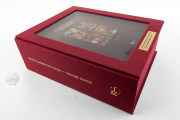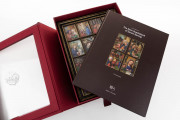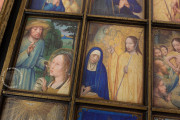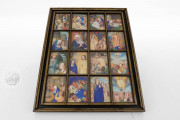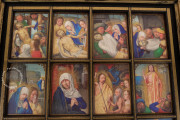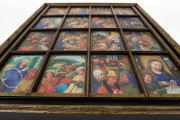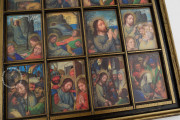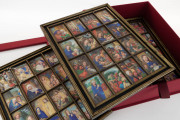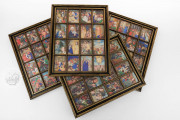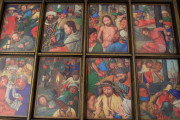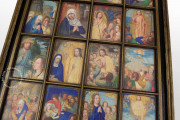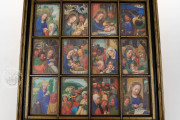The Stein Quadriptych presents powerful narrative cycles by the renowned Flemish illuminator Simon Bening and associates. The assemblage of paintings mounted on wooden panels creates a unique altarpiece that showcases Bening's compositional mastery in a series of Christian devotional images. Probably painted in Bruges around 1525-1530, the quadriptych's sixty-four miniatures are mounted on four panels, each bearing sixteen miniatures. Painted in the vivid palette for which Bening is celebrated and highlighted sparingly with gold, each miniature is relatively small (6.8 × 5.2 cm).
The ambitious picture cycle takes the viewer through the life of the Virgin Mary; the infancy, ministry, and Passion of Christ; and the history of the Church, beginning with the embrace of Mary's parents, Anna and Joachim, at the Golden Gate of Jerusalem and ending with the Last Judgment.
Miniatures on Panel
The assembly of small miniatures painted on parchment and mounted on panels is unusual, and it is unclear whether these miniatures were created for an altarpiece like this or for inclusion in a small devotional book. Furthermore, the panels themselves postdate the miniatures, and there is also the question of why one would paint sixty-four independent paintings, as opposed to composite miniatures, to be mounted on panels.
Another puzzle is that the miniatures do not appear to be uniformly exposed or worn: some are in better condition than others, which probably would not be the case had they been attached to the panels since the time of their painting. The gilded lattice-work frame is not original and likely dates from the last quarter of the nineteenth century. Among the surviving corpus of Bening's prolific artistic output, this is the only compilation like this.
A Harmonious Ensemble
Despite the variation in apparent exposure, the scenes' palette and composition suggest that the series was meant to be viewed as an ensemble. The miniatures may have been created in Bening's workshop for sale at the marketplace, with the matter of format left to the purchaser.
Dramatic Close-Up
While many questions remain unanswered, it is clear that the miniatures of the Stein Quadriptic comprise one of Bening's most powerful artistic conceptions. Exploiting the empathic close-up—for which Bening is renowned—the miniatures offer dramatic insight into the narratives and flaunt the illuminator's powerful story-telling abilities. Although the ensemble is independent of text, the sophisticated visual program is likely to have elicited the recitation of prayer.
Unknown Patronage, Uncharted History
The Stein Quadriptych has been associated with Cardinal Albrecht of Brandenburg (1490-1545), Archbishop and Elector of Mainz, because its imagery seems to grow out of a prayer book he commissioned that was illuminated by Bening (Los Angeles, J. Paul Getty Museum, MS Ludwig IX 19).
The miniatures received their Stein association from their first known owner: Charles Stein (nineteenth century). Their current arrangement may be due to his intervention. Someone named Bourgeois purchased the quadriptych in 1886. The ensemble's ownership is only clear again in 1911 when it arrived in a shipment in New York destined for the collector Henry Walters (1848-1931). Walters bequeathed the art collection begun by his father to the City of Baltimore, and the quadriptych was in the original collection of the Walters Art Gallery (since 2000, Walters Art Museum), established in 1934.
We have 1 facsimile edition of the manuscript "Stein Quadriptych": Stein Quadriptych facsimile edition, published by Mueller & Schindler, 2012
Request Info / Price

